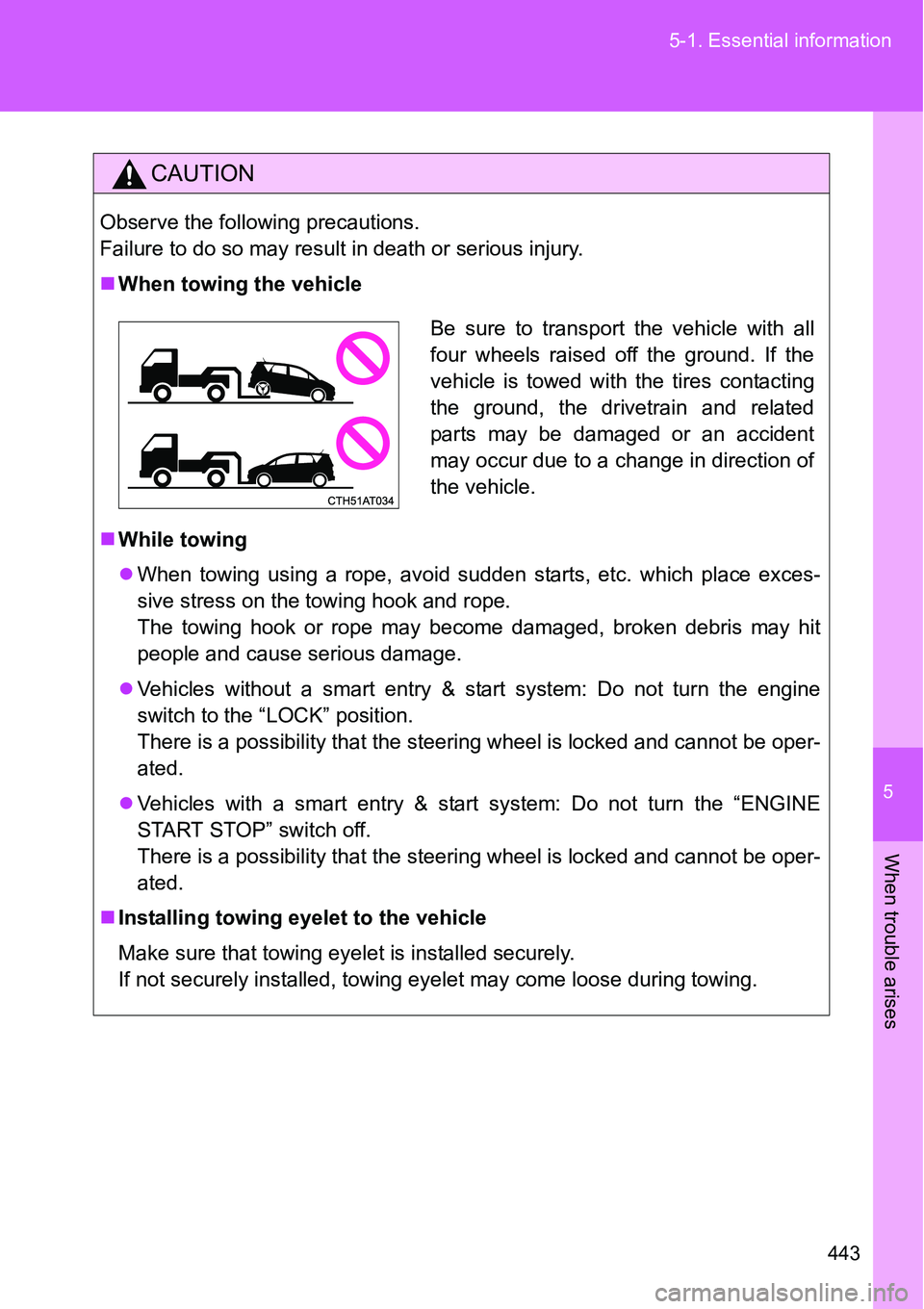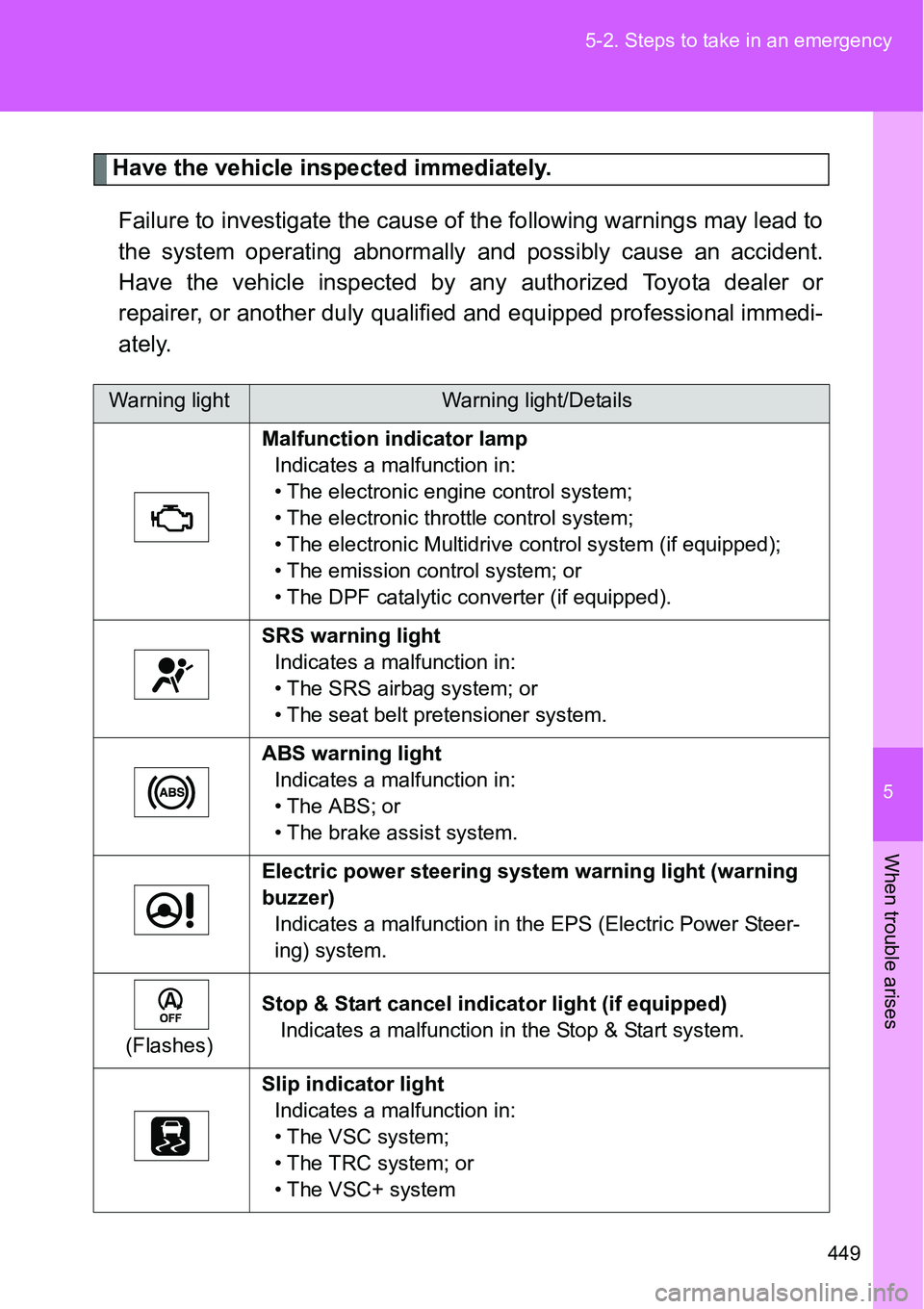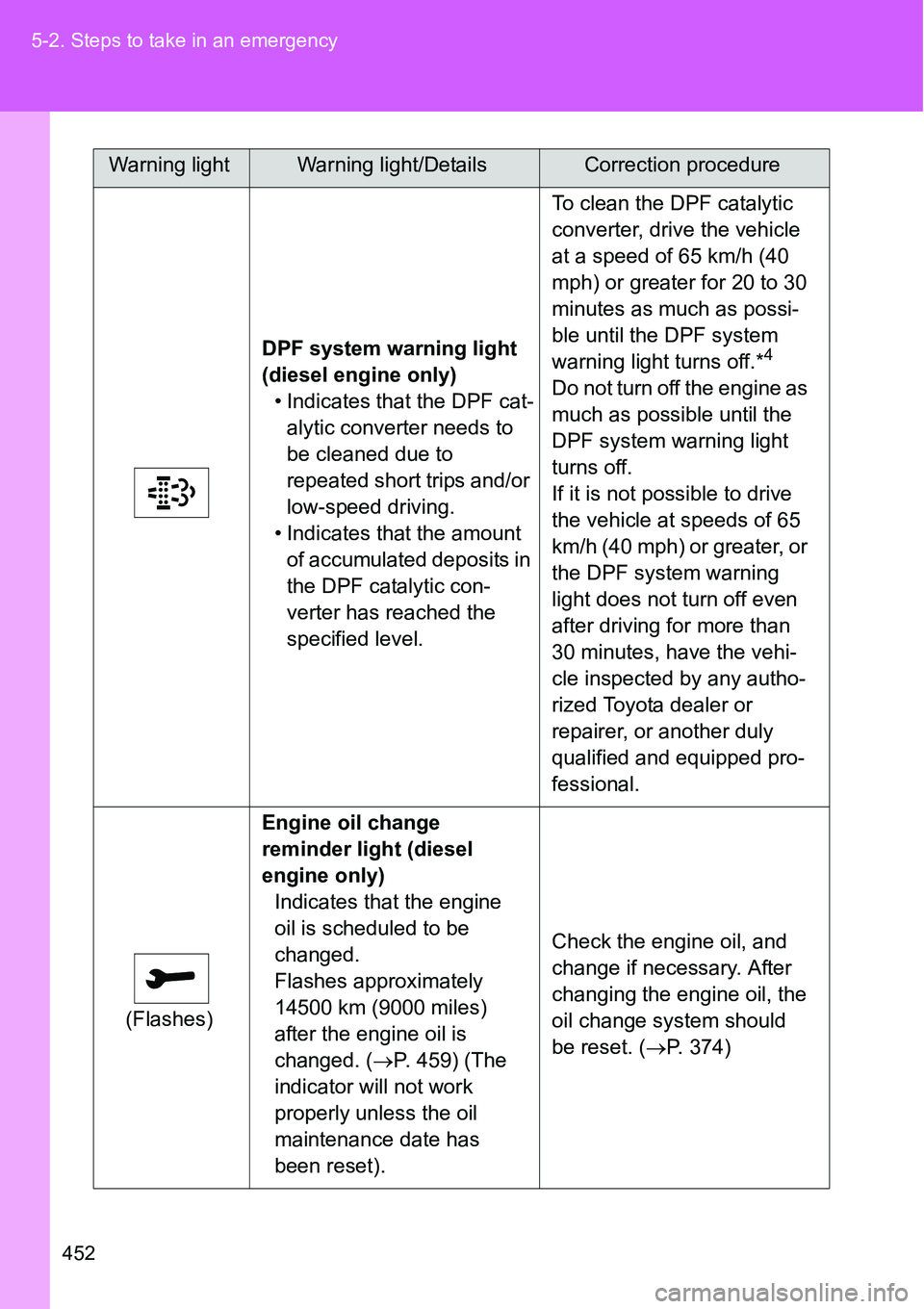Page 443 of 564

5
443 5-1. Essential information
When trouble arises
CAUTION
Observe the following precautions.
Failure to do so may result in death or serious injury.
When towing the vehicle
While towing
When towing using a rope, avoid sudden starts, etc. which place exces-
sive stress on the towing hook and rope.
The towing hook or rope may become damaged, broken debris may hit
people and cause serious damage.
Vehicles without a smart entry & start system: Do not turn the engine
switch to the “LOCK” position.
There is a possibility that the steering wheel is locked and cannot be oper-
ated.
Vehicles with a smart entry & start system: Do not turn the “ENGINE
START STOP” switch off.
There is a possibility that the steering wheel is locked and cannot be oper-
ated.
Installing towing eyelet to the vehicle
Make sure that towing eyelet is installed securely.
If not securely installed, towing eyelet may come loose during towing.
Be sure to transport the vehicle with all
four wheels raised off the ground. If the
vehicle is towed with the tires contacting
the ground, the drivetrain and related
parts may be damaged or an accident
may occur due to a change in direction of
the vehicle.
Page 445 of 564

5
445
5-1. Essential information
When trouble arises
If you think something is wrong
If you notice any of the following symptoms, your vehicle probably
needs adjustment or repair. Contact any authorized Toyota dealer or
repairer, or another duly qualified and equipped professional as
soon as possible.
Visible symptoms
Fluid leaks under the vehicle
(Water dripping from the air conditioning after use is normal.)
Flat-looking tires or uneven tire wear
High engine coolant temperature warning light flashes or
comes on
Low engine coolant temperature indicator comes on or does
not come on continuously
Audible symptoms
Changes in exhaust sound
Excessive tire squeal when cornering
Strange noises related to the suspension system
Pinging or other noises related to the engine
Operational symptoms
Engine missing, stumbling or running roughly
Appreciable loss of power
Vehicle pulls heavily to one side when braking
Vehicle pulls heavily to one side when driving on a level road
Loss of brake effectiveness, spongy feeling, pedal almost
touches the floor
Page 446 of 564
446
5-1. Essential information
Fuel pump shut off system (gasoline engine only)
Follow the procedure below to restart the engine after the system is
activated.
Vehicles without a smart entry & start system
Turn the engine switch to the “ACC” or “LOCK” position.
Restart the engine.
Vehicles with a smart entry & start system
Turn the “ENGINE START STOP” switch to ACCESSORY mode
or turn it off.
Restart the engine.
NOTICE
Before starting the engine
Inspect the ground under the vehicle.
If you find that fuel has leaked onto the ground, the fuel system has been
damaged and is in need of repair. Do not restart the engine.
To minimize the risk of fuel leakage when the engine stalls or when
an airbag inflates upon collision, the fuel pump shut off system
stops the supply of fuel to the engine.
STEP1
STEP2
STEP1
STEP2
Page 448 of 564
448 5-2. Steps to take in an emergency
Stop the vehicle immediately.
The following warnings indicate the possibility of damage to the vehi-
cle that may lead to an accident. Immediately stop the vehicle in a
safe place and contact any authorized Toyota dealer or repairer, or
another duly qualified and equipped professional.
Warning lightWarning light/Details
Charging system warning light
Indicates a malfunction in the vehicle’s charging system.
Low engine oil pressure warning light
Indicates that the engine oil pressure is too low.
(Flashes or
comes on in
red)High engine coolant temperature warning light
Indicates that the engine is almost overheating. (P. 509)
Page 449 of 564

5
449 5-2. Steps to take in an emergency
When trouble arises
Have the vehicle inspected immediately.
Failure to investigate the cause of the following warnings may lead to
the system operating abnormally and possibly cause an accident.
Have the vehicle inspected by any authorized Toyota dealer or
repairer, or another duly qualified and equipped professional immedi-
ately.
Warning lightWarning light/Details
Malfunction indicator lamp
Indicates a malfunction in:
• The electronic engine control system;
• The electronic throttle control system;
• The electronic Multidrive control system (if equipped);
• The emission control system; or
• The DPF catalytic converter (if equipped).
SRS warning light
Indicates a malfunction in:
• The SRS airbag system; or
• The seat belt pretensioner system.
ABS warning light
Indicates a malfunction in:
• The ABS; or
• The brake assist system.
Electric power steering system warning light (warning
buzzer)
Indicates a malfunction in the EPS (Electric Power Steer-
ing) system.
(Flashes)Stop & Start cancel indicator light (if equipped)
Indicates a malfunction in the Stop & Start system.
Slip indicator light
Indicates a malfunction in:
• The VSC system;
• The TRC system; or
• The VSC+ system
Page 450 of 564
450 5-2. Steps to take in an emergency
Follow the correction procedures.
After taking the specified steps to correct the suspected problem,
check that the warning light goes off.
Fuel filter warning light (diesel engine only)
Indicate that the amount of accumulated water in the fuel
filter has reached the specified level.
(Yellow)Cruise control indicator light (if equipped)
Indicates a malfunction in the cruise control system.
(Flashes in
yellow for 15
seconds.)Smart entry & start system indicator light (If equipped)
Indicates a malfunction in the smart entry & start system.
Warning lightWarning light/DetailsCorrection procedure
Parking brake indicator
light (warning buzzer)*
1
Indicates that the parking
brake is not released.Release the parking brake.
Open door warning light
(warning buzzer)*
2
Indicates that a door is not
fully closed.Check that all doors are
closed.
Warning lightWarning light/Details
Page 451 of 564
5
451 5-2. Steps to take in an emergency
When trouble arises
Low fuel level warning
light
Gasoline engine: Indi-
cates that remaining fuel is
about 5.8 L (1.5 gal., 1.3
Imp. gal.) or less.
Diesel engine: Indicates
that remaining fuel is
about 6.4 L (1.7 gal., 1.4
Imp. gal.) or less.Refuel the vehicle.
(On the instru-
ment cluster)Driver’s and front passen-
ger’s seat belt reminder
light (warning buzzer)*
3
Warns the driver and front
passenger to fasten their
seat belts.Fasten the seat belt.
(On the center
panel)Rear passengers’ seat
belt reminder lights
(warning buzzer)*
3
Warns the rear passen-
gers to fasten their seat
belts.Fasten the seat belt.
Low engine oil level warn-
ing light (diesel engine
only)
Indicates that engine oil
level is low.Check the level of engine
oil, and add if necessary.
Warning lightWarning light/DetailsCorrection procedure
Page 452 of 564

452 5-2. Steps to take in an emergency
DPF system warning light
(diesel engine only)
• Indicates that the DPF cat-
alytic converter needs to
be cleaned due to
repeated short trips and/or
low-speed driving.
• Indicates that the amount
of accumulated deposits in
the DPF catalytic con-
verter has reached the
specified level.To clean the DPF catalytic
converter, drive the vehicle
at a speed of 65 km/h (40
mph) or greater for 20 to 30
minutes as much as possi-
ble until the DPF system
warning light turns off.*4
Do not turn off the engine as
much as possible until the
DPF system warning light
turns off.
If it is not possible to drive
the vehicle at speeds of 65
km/h (40 mph) or greater, or
the DPF system warning
light does not turn off even
after driving for more than
30 minutes, have the vehi-
cle inspected by any autho-
rized Toyota dealer or
repairer, or another duly
qualified and equipped pro-
fessional.
(Flashes)Engine oil change
reminder light (diesel
engine only)
Indicates that the engine
oil is scheduled to be
changed.
Flashes approximately
14500 km (9000 miles)
after the engine oil is
changed. (P. 459) (The
indicator will not work
properly unless the oil
maintenance date has
been reset).Check the engine oil, and
change if necessary. After
changing the engine oil, the
oil change system should
be reset. (P. 374)
Warning lightWarning light/DetailsCorrection procedure